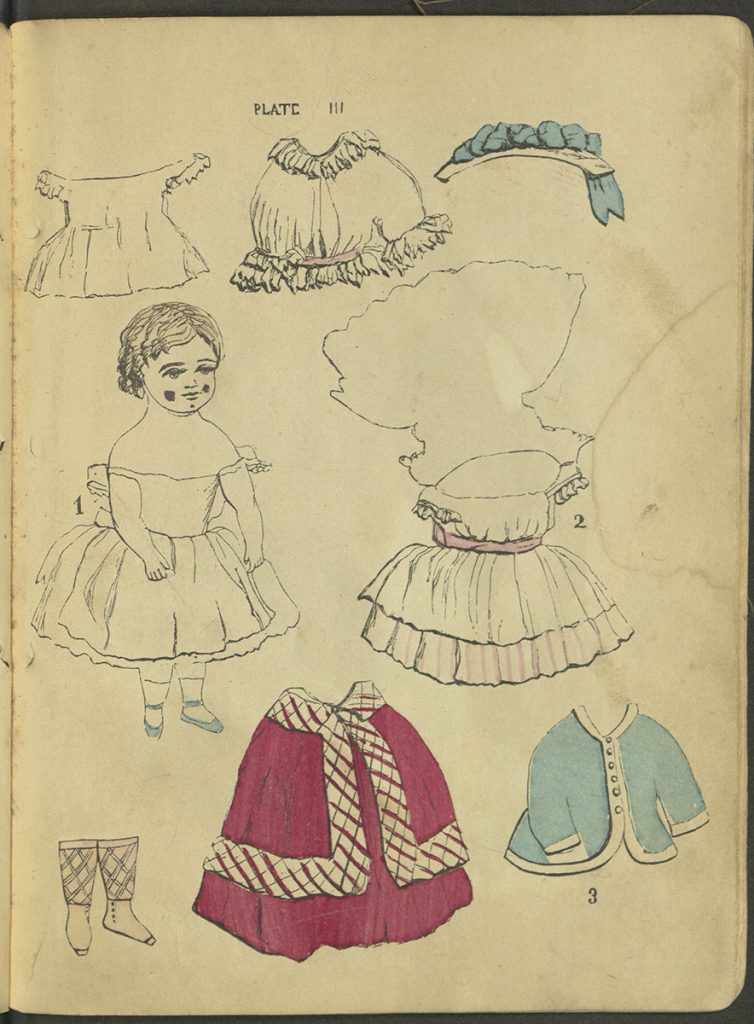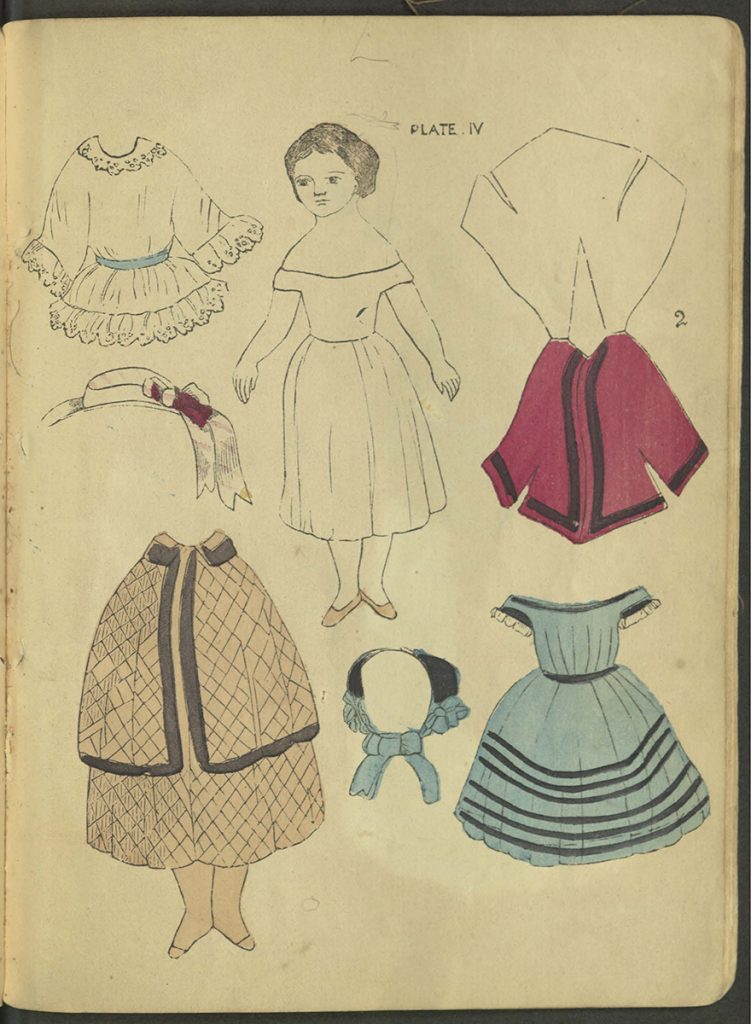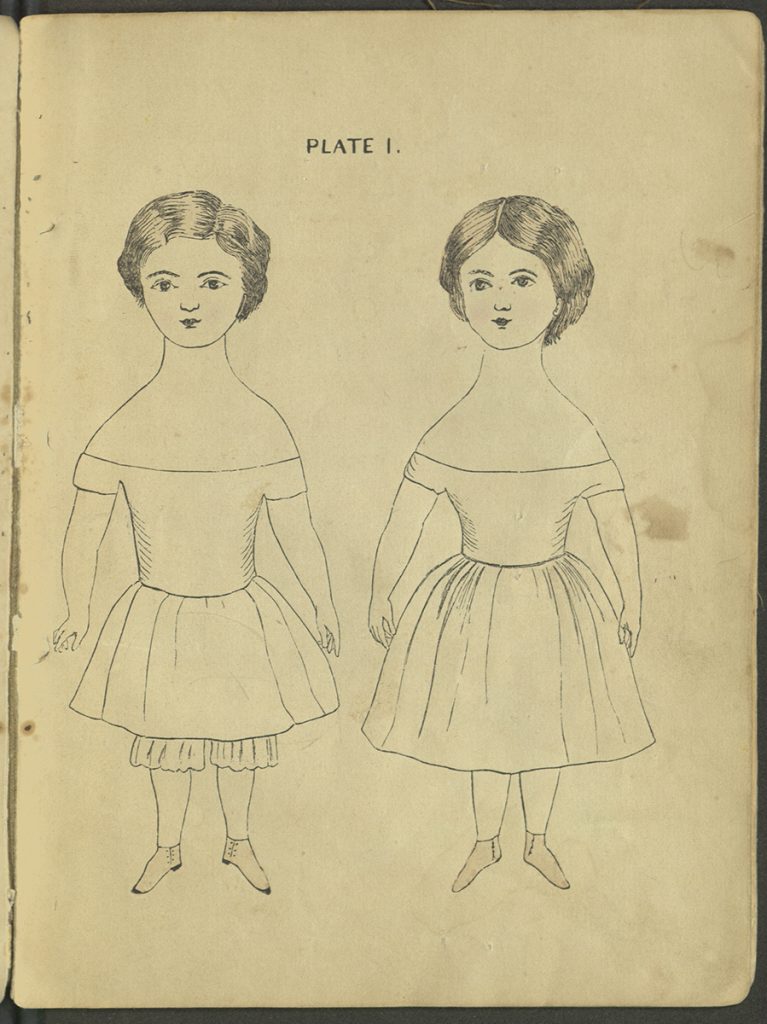My Dear Young Friends :
I have often pitied myself, because there were no Paper Dolls when I was a little girl. I supposed that all little girls, now-a-days, played with them, until a few days ago, when a lady told me that she knew a number, who had never heard of Paper Dolls, and then she said: “Why can’t you make a little book, and tell how to make them?” And Mary looked up and said, “Please, do, Mamma, it would make a great many children happy.”
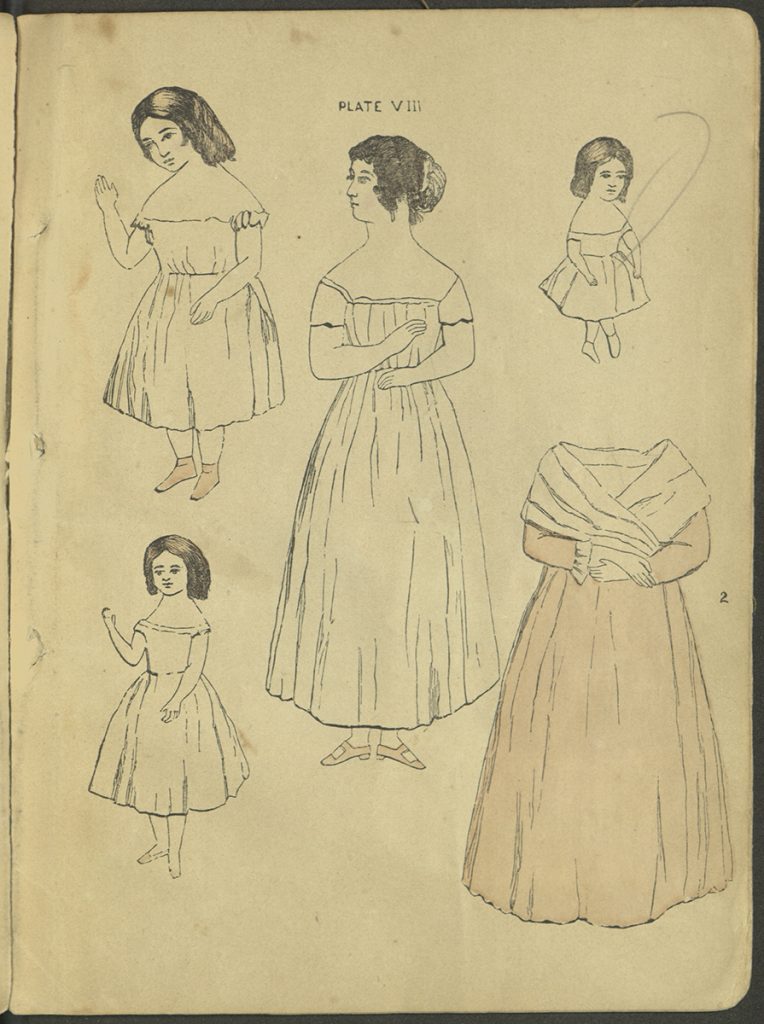 This first American book on making paper dolls was published anonymously in 1857. The author is enthusiastic about making dolls at home and playing with them. Her enumeration of types of dolls suggests scenarios for play: “Babies to be nursed and fondled, little girls and boys to be taught and entertained, rewarded and punished, mammas to keep house, and go visiting, and take care of the little ones.” She expects the dolls will be given names and histories – and attend parties, “if you allow your little people to go to such places.”
This first American book on making paper dolls was published anonymously in 1857. The author is enthusiastic about making dolls at home and playing with them. Her enumeration of types of dolls suggests scenarios for play: “Babies to be nursed and fondled, little girls and boys to be taught and entertained, rewarded and punished, mammas to keep house, and go visiting, and take care of the little ones.” She expects the dolls will be given names and histories – and attend parties, “if you allow your little people to go to such places.”
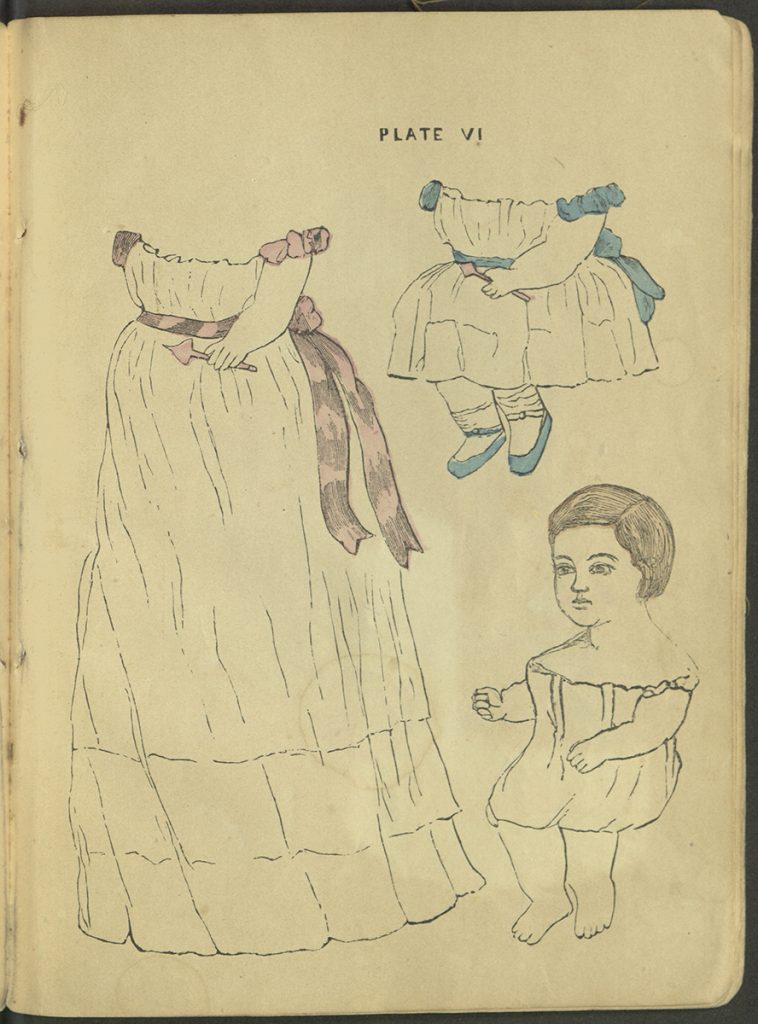 Most of the book, though, focuses on technical details of producing and clothing the dolls. The dolls themselves are made of “Any kind of stiff paper, the backs of old cards, paste-board, Bristol board,” and the costumes from scraps and leftover bits of paper. The author lists various sorts of colored paper the girl may be able to scavenge: covers of pamphlets, note or letter paper, tissue “motto papers” (imagine the pink, blue, and green amaretti wrappers); plain brown or white paper to draw or paint on; minuscule scraps of gold paper; and even tiny feathers for hats. With these materials, a pencil, scissors, and a bottle of gum arabic, the girl is “prepared to do great things in the millinery and dressmaking line.”
Most of the book, though, focuses on technical details of producing and clothing the dolls. The dolls themselves are made of “Any kind of stiff paper, the backs of old cards, paste-board, Bristol board,” and the costumes from scraps and leftover bits of paper. The author lists various sorts of colored paper the girl may be able to scavenge: covers of pamphlets, note or letter paper, tissue “motto papers” (imagine the pink, blue, and green amaretti wrappers); plain brown or white paper to draw or paint on; minuscule scraps of gold paper; and even tiny feathers for hats. With these materials, a pencil, scissors, and a bottle of gum arabic, the girl is “prepared to do great things in the millinery and dressmaking line.”
The ten plates show one or more “patterns” for dolls to trace or redraw or imitate, and sample sketches of types of clothing to make from the accumulated stash of useful paper.
Some of us had paper dolls when we were young where the clothing was held on the doll by folded over paper tabs. And we have seen in our examination of Little Fanny that the early nineteenth century saw commercial printing of paper dolls whose head moved from garment to garment. The author of our book is excited about a different technology: “Now the great invention, from which Paper-Doll playing may be said to have its beginning, consists simply in making the dresses doubled at the top, so that they may stay on. I consider this one of the greatest discoveries of modern times.… The way is simply this; to fold the paper of which the dress is to be made, having the fold at the top, so that the dress is cut double, front and back, and the folded part makes a shoulder-strap.”
For high-necked clothing the head will not fit through, a long opening is made in the back. The author also gives tips on hats, shoes and stockings, garments which might obscure the doll’s arms, and so on.
The author is troubled about the dolls’ appearance. She knows most children do not draw naturalistically and also that it doesn’t bother them at all: ‘[the dolls] may be cross-eyed, and their foreheads may be larger than all the rest of their faces, and their heads may grow out of their shoulders, and their fat arms may stand out straight, and end in little knobs. [I]t is all the same, they are “little darlings,” “perfect beauties,” “the sweetest little things that ever were seen.”’
But she wishes the dolls were better. She instructs the young artists to try to make the faces symmetrical, and to practice on a slate before committing to paper – although she expects they will be disappointed in the results. She advises them that if their first doll is “horrid-looking” they should dress it and give it to their baby sister who won’t know any better – and make another. And “if this second one does not look as well as you hoped it would, still I think that you had best make a dress or two for it.” She clearly has experience with the painful fact that ability only improves with practice – and that somehow the aspiring artist must both feel badly enough about the product to want to do better, and good enough about the process to repeat the effort.
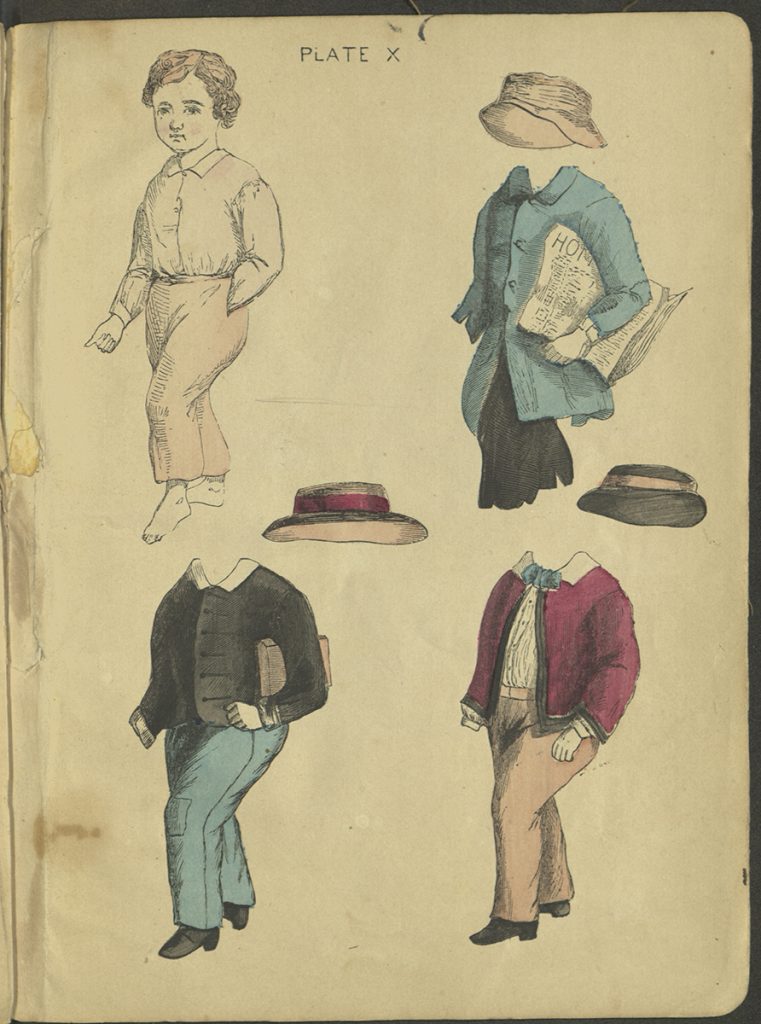 She finishes up with encouraging remarks and an appeal to thrift: “There is no end to the pretty things that you can make. You will soon collect, in one way or another, the simple materials which you can convert into beautiful dresses. I am sure that you and your mothers will all agree with me in saying that playing with Paper Dolls is the most delightful, the most varied, and at the same time the most simple and the least expensive of all your amusements.”
She finishes up with encouraging remarks and an appeal to thrift: “There is no end to the pretty things that you can make. You will soon collect, in one way or another, the simple materials which you can convert into beautiful dresses. I am sure that you and your mothers will all agree with me in saying that playing with Paper Dolls is the most delightful, the most varied, and at the same time the most simple and the least expensive of all your amusements.”
I can tell you from my own experience that it is fun to dress the dolls. You can use any combination of drawing, copying, collage, or Photoshop you like. I printed out one of the dolls, glued it onto card stock, gave it legs, then dressed it from paper scraps. Try it and let us know what you made!
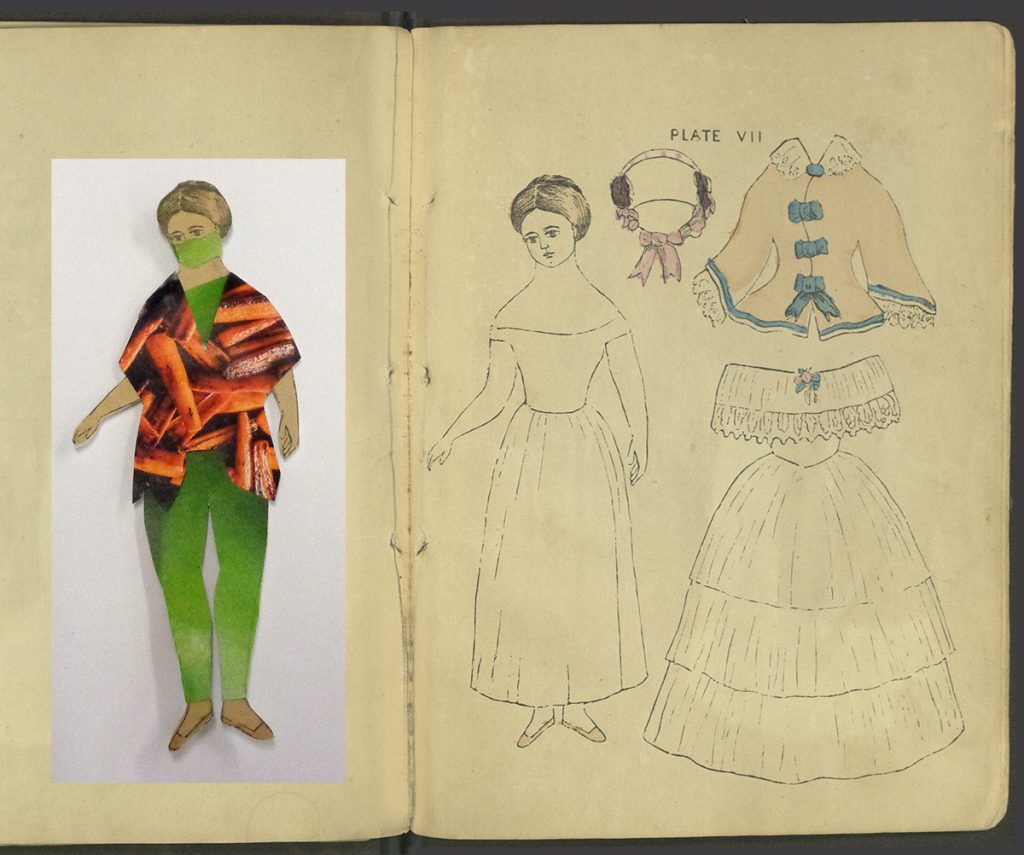
Marianne’s paper doll, created from one of the original patterns. The costume was made from a Cook’s Illustrated magazine: the wearable art jacket was cut from a photo of pan-roasted carrots, the leggings, shell, and mask from a painting of a pomelo.
– Marianne Hansen, Curator of Rare Books and Manuscripts
Paper Dolls, and How to Make Them: A Book for Little Girls. New edition, improved and enlarged.
New-York: Anson D.F. Randolph, 683 Broadway., 1857.
Our copy of the book can be read on the Internet Archive.
With the continuing closure of the Library, we are blogging regularly about books from the exhibition, The Girl’s Own Book. The exhibition’s run has been extended through the 2020-2021 academic year. Information about when it will open to visitors and related programming will be available when we are able to give it. Please follow us on Facebook or subscribe here for notices of new blog posts.

